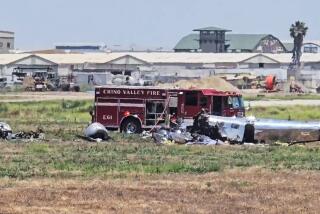China leaders were nearby during apparent Tiananmen Square attack
BEIJING -- Chinese President Xi Jinping and the six other top officials reportedly were at Tiananmen Square on Monday when a vehicle crashed and exploded nearby, leaving five dead.
Although there is no indication that the physical safety of the leaders, who were attending meetings inside the Great Hall of the People, was jeopardized, the apparent suicide attack so close to the epicenter of power rattled the Chinese government and has raised doubts about the effectiveness of its often-stifling security apparatus.
The three occupants of the car, suspected of being members of the Uighur ethnic minority, were killed along with two tourists, one a Filipina and the other a Chinese man. Thirty-eight people were injured.
“It is clear that China does not have a counter-terrorism capability. Their capabilities are very rudimentary, and they need to develop them,” said Rohan Gunaratna, a Singapore-based terrorism expert who has written widely on Uighur separatism. He attributed the attack to the East Turkestan Islamic Movement, a shadowy group based in northwestern China’s Xinjiang region.
Witnesses said that police were unable to stop the car, which traveled nearly 500 yards from an intersection before exploding.
Besides Xi, Premier Li Keqiang and the five other members of the Politburo Standing Committee -- the innermost circle -- were in the Great Hall of the People, on the west side of the square, about 200 yards away. In the morning, they were attending a meeting with the China Women’s Federation and in the afternoon, a South African government delegation.
“The incident happened at Tiananmen Square while an important government conference was taking place. The suddenness of the incident alarmed the central government,” wrote a commentator on Duowei, an overseas Chinese news service with close ties to the Chinese Communist Party. The report said the investigation was assigned at the highest level to Fu Zhenghua, deputy public security minister, and that “many arrests are expected.”
The Chinese government has not called the incident a terror attack, although witness statements suggest that it was deliberate.
The car entered a pedestrian area, drove for about 500 yards along the north side of the square, hitting tourists and police on the sidewalk, before crashing against a guardrail protecting a stone pedestrian bridge. It then exploded underneath the square’s enormous portrait of Mao Tse-tung, the spiritual heart of China.
Francesca Bunyi, a 23-year-old Filipina injured in the incident, told friends who visited her in a Beijing hospital on Tuesday that driver of the car was honking the horn to chase pedestrians out of the way, trying to reach the Mao portrait while avoiding obstacles. She said she did not hear gunshots.
“All we heard was honking, honking from far away,” a friend quoted her as saying.
“The police tried to stop the vehicle, but no one had guns,” said a young man from Shandong province who was interviewed over an instant messaging service. “The vehicle was not going very fast because two people got stuck under its wheels. The armed police were shouting at the vehicle, asking it to stop.”
“The vehicle slammed into the bridge and stopped. And then there was an explosion. ... I was about three meters away from the explosion, but I wasn’t hurt because it wasn’t very strong,’” said the man, who did not wish to be named.
He also said that he saw hanging from the passenger side of the car a dark-colored flag with Arabic script, which is used in the Uighur language. A report carried by the Reuters news agency referred to a white banner.
On Monday evening, Beijing police sent out a notice to hotels saying that people should keep an eye out for two men, one 25-years-old and the other 42-years-old, from a part of Xinjiang that has been racked by violence since the spring. It was unclear whether the men were among those killed in the car, but the notice said that police feared further incidents because the men had additional license plates, and possibly additional cars.
The men named come from the outskirts of the desert oasis of Turpan, where dozens have been killed this year following the killing in March of a 7-year-old Uighur boy. In June, at least 35 people were killed in Pichan county, also known as Shanshan, where the suspects named Monday came from.
About 9 million Uighurs live in China’s northwestern most Xinjiang region, often bristling at restrictions on their employment, freedom of movement and the practice of religion.
Between Chinese security sources and human rights advocates, there is a gaping divide over whether episodes of Uighur violence are spontaneous reactions to oppression or organized terror attacks.
Over the past decade, Western security sources have linked the East Turkestan (the name refers to Xinjiang) movement to Al Qaeda, although the group has been weakened by the U.S. effort in Afghanistan.
“It continues to maintain a small but capable presence on the Afghanistan-Pakistan border,” said Gunaratna, the Singapore academic. “They pose a continuous threat to China. They have attempted other attacks before outside Xinjiang, but this attack [at Tiananmen Square] is the first time they succeeded.”
In the run-up to the 2008 Beijing Summer Olympics, Chinese authorities said they foiled several attempted attacks, including an airplane hijacking.
The Chinese government appears to be embarrassed by Monday’s attack. The story was given little coverage in state media, and foreign broadcasts on cable television were blacked out.
The government announced Tuesday that a major Communist Party plenum to discuss possible economic reforms will take place Nov. 9-12.
ALSO:
Two militants reported killed in U.S. drone attack in Somalia
Iranian-born suspect charged with endangering L.A.-bound plane
Nearly 6 months into Snowden affair, opinion still split on motives
barbara.demick@latimes.com
More to Read
Sign up for Essential California
The most important California stories and recommendations in your inbox every morning.
You may occasionally receive promotional content from the Los Angeles Times.










